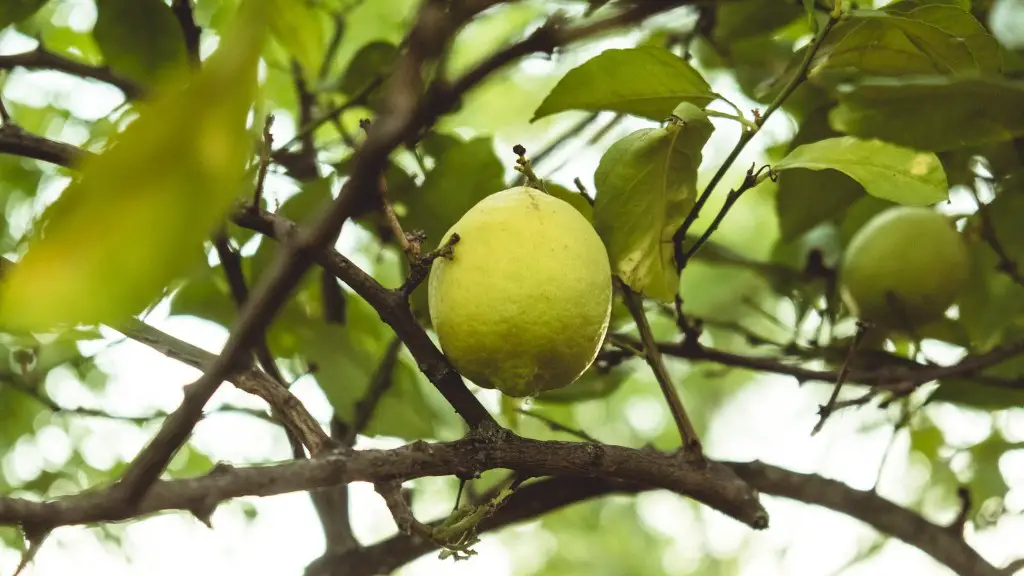For gardeners wanting to find out how to identify a lemon tree, there are a few key elements to be aware of. Firstly, lemon trees have fruit that is round and bright yellow. This fruit is juicy and tart. The fruit grows on branches that have thorns on them, and the leaves are green and have a glossy finish. Secondly, lemon trees can be identified by their flowers, which are small white in colour and have a strong, lemony scent. Thirdly, lemon trees can be recognised by their bark, which is grey in colour with some gray/green patches. Fourthly, lemon trees have a spreading form and typically reach a height of up to 8 metres. Lastly, lemon trees can be clearly identified by their aroma, which is a combination of citric, sweet and sour scents.
Climate
Lemon trees thrive in areas where temperatures remain consistently warm and sunny. This makes tropical and subtropical climates ideal locations for the growth of lemon trees, as they prefer warm, sunny places with soil that has sufficient drainage to avoid water pooling. If temperatures become too cold or drop below freezing, lemon trees can become severely damaged and may even die.
Soil Requirements
For lemon trees to grow healthily, they need to be planted in soil that is nutrient rich and has good drainage. Although lemon trees are considered relatively drought tolerant, the soil should be moist to some degree and have sufficient nutrients for growth. If the soil is too compact and lacks essential nutrients, it can lead to stunted growth and even death of the tree.
Fertiliser
The nutrients that became depleted from the soil can be replaced and supplemented with the use of fertiliser. Apply chemical fertiliser three to four times a year and organic fertiliser bi-monthly. Be aware that over-fertilising can burn the roots and cause the leaves to become yellow and limp.
Pruning & Pruning Frequency
Pruning a lemon tree is important to promote healthy growth. Pruning is best done in the warmer months and shortly after the tree has flowered, as this encourages it to become more productive. It is important when pruning not to cut back too much, as this can damage a lemon tree and make it less productive in the long run.
Pests & Disease
Just like with any plant, lemon trees can become prone to pests and diseases. To avoid this, regularly inspect the tree and the surrounding area for any suspicious activity. If any pests or diseases are found, treat them immediately using the appropriate methods, such as organic insecticides and fungicides.
Watering
Lemon trees need to be watered consistently as dry soil can lead to them becoming stunted and weaker over time. Deep watering once per week is recommended for optimal growth, with more frequent watering during warmer months. Be sure not to over-water, as this can lead to root rot or cause the trunk or branches to split.
Harvesting & Storage
Lemon trees can be ready to be harvested in late spring or early summer, depending on their age and environment. When ready, the lemons should be picked off the tree by hand, using a pair of scissors if necessary. Lemons can be stored for up to 4 weeks in the refrigerator, but for longer storage, they can be frozen or preserved in lemon juice.
Frost Protection
in cooler climates, lemon trees may need additional protection from the cold. This can be achieved by covering them with blankets or plastic once temperatures start to drop. Special frost-resistant varieties may also be available, so be sure to ask your local nursery for advice. Additionally, lemon trees need to be stored in a cool location during the winter months and should be brought inside if temperatures drop below -2 degrees Celsius.
Vermin Control
Lastly, vermin such as rodents and insects can be a problem for lemon trees. Take steps to prevent any critters from attacking the tree by setting out traps, using insecticides and conducting regular inspections. If vermin is spotted, respond quickly to reduce any potential damage.


